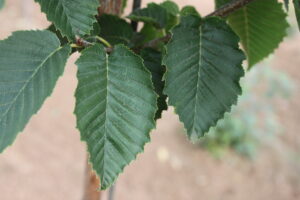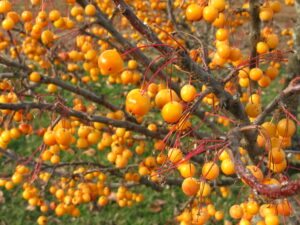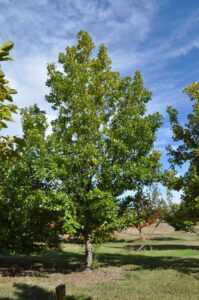Yearly, researchers at Colorado State University (CSU) evaluate over 1,300 taxa of woody plants for adaptability, ornamental flowers, fruit, fall color and pest problems. Environmental Horticulture students help maintain the test sites with support from Colorado Horticulture Research and Education Foundation (CHREF), J. Frank Schmidt Charitable Trust, Bailey Nursery Inc., Colorado Agricultural Experiment Station and numerous national and local nurseries.
CSU is happy to announce a new website for all woody plant research, which makes it easier for the public and industry to find the most popular information. The photo library links to data, where applicable, and photos can be downloaded. Check it out at woodyplants.colostate.edu.
The following seven woody plants have proven to be outstanding at the CSU Heritage Arboretum and would be worth considering for Colorado landscapes.
1. Carpinus betulus ‘JFS-KW1CB’ PP 22814 – Emerald Avenue® Hornbeam from J. Frank Schmidt and Son Co.

This Hornbeam has a narrow upright oval growth habit when young but it matures to a broader growth habit. Summer foliage is dark green and turns yellow in the fall. It matures to about 35-40 feet in height and 20-25 feet in width. Its strong central leader and sturdy branch arrangements make it a good street tree. It also has good heat tolerance.
2. Catalpa speciosa ‘Hiawatha’ – Heartland® Catalpa from J. Frank Schmidt and Son Co.

Heartland® Catalpa has an upright to narrow oval growth habit with large leaves that are medium to dark green. Leaves turn yellow-green in the fall. The tree matures to about 40 feet in height and 20 feet in width, having an upright growth habit with uniform branching. This clone has large clusters of white flowers.
3. Maackia amurensis ‘JFS-Schichtel1’ – MaacNificent® Amur maackia from J. Frank Schmidt and Son Co.

This maackia has vigorous growth. Upright branching creates a symmetrical vase-shaped growth habit. Its medium-green leaves have a silvery tint and turn yellow in the fall. The tree grows to about 25 feet in height and 20 feet in width and adapts to wide range of soil conditions. Spike-like white raceme flowers are evident in early summer.
4. Malus ‘JFS-KW207’ PP 27954 – Sparkling Sprite® Crabapple from J. Frank Schmidt and Son Co.

This top-grafted dwarf crabapple has as a dense, round growth habit and matures to 10-12 feet in height and width. Foliage is medium green turning to orange-red in the fall. Summer foliage is reported to have excellent disease resistance. Abundant yellow fruit follows flowering and fruit persists into winter. It’s a good tree for confined spaces.
5. Quercus x macdanielii ‘Clemons’ – Heritage® Oak from Bailey Nurseries

This oak has a broad pyramidal growth habit that eventually becomes more oval. It’s a cross between Quercus robur (English) and Quercus macrocarpa (Bur) and matures to about 50 feet in height and 30 feet in width. Its glossy, dark green leaves are disease resistant. An excellent shade tree, it was originally developed by Heritage Trees, Inc., and adapts to lower water after established.
6. Rosa ‘BaIface’ PP15,753 – Easy Elegance ® Funny Face Rose from Bailey Nurseries

Funny Face has an upright to rounded growth habit and matures to 2-3 feet in height and width. Foliage is dark green with prolific pink to white blooms. Peak flowering is in June but some blooming is maintained all season. Flower color is variable. No two flowers are the same, making it unique. This low maintenance rose has good disease resistance and tolerates drought once established.
7. Ulmus davidiana ‘JFS KW2UD’ – Greenstone® Elm from J. Frank Schmidt and Son Co.

This tree has strong branch angles that develop into an upright vase shape resembling that of the American Elm. It matures to about 50 feet in height and 35-50 feet in width. The foliage is a medium green, turning yellow in the fall. This tree is thought to have resistance to Dutch Elm disease and phloem necrosis and is a top performer among trees grown from seed from its native range in China.










